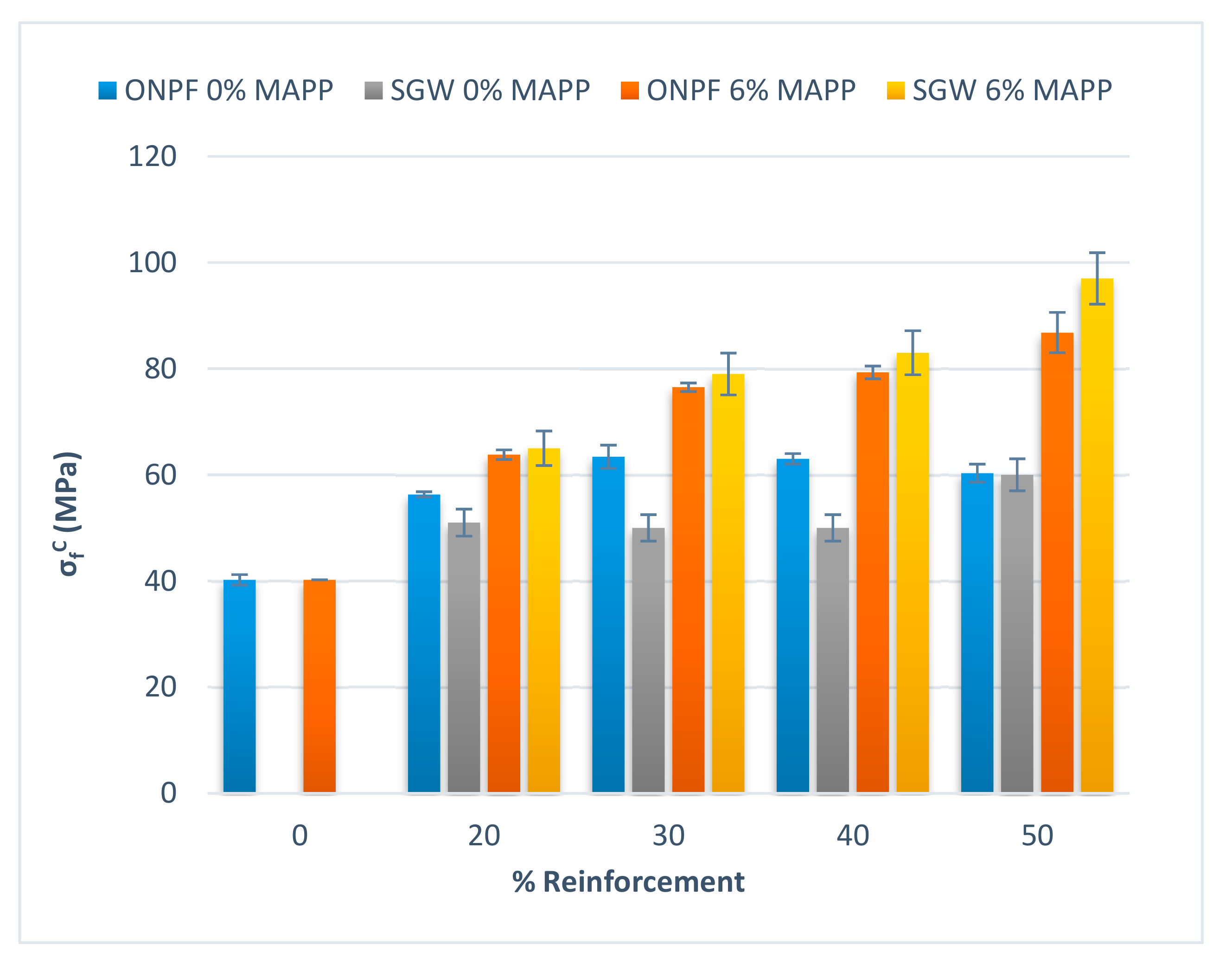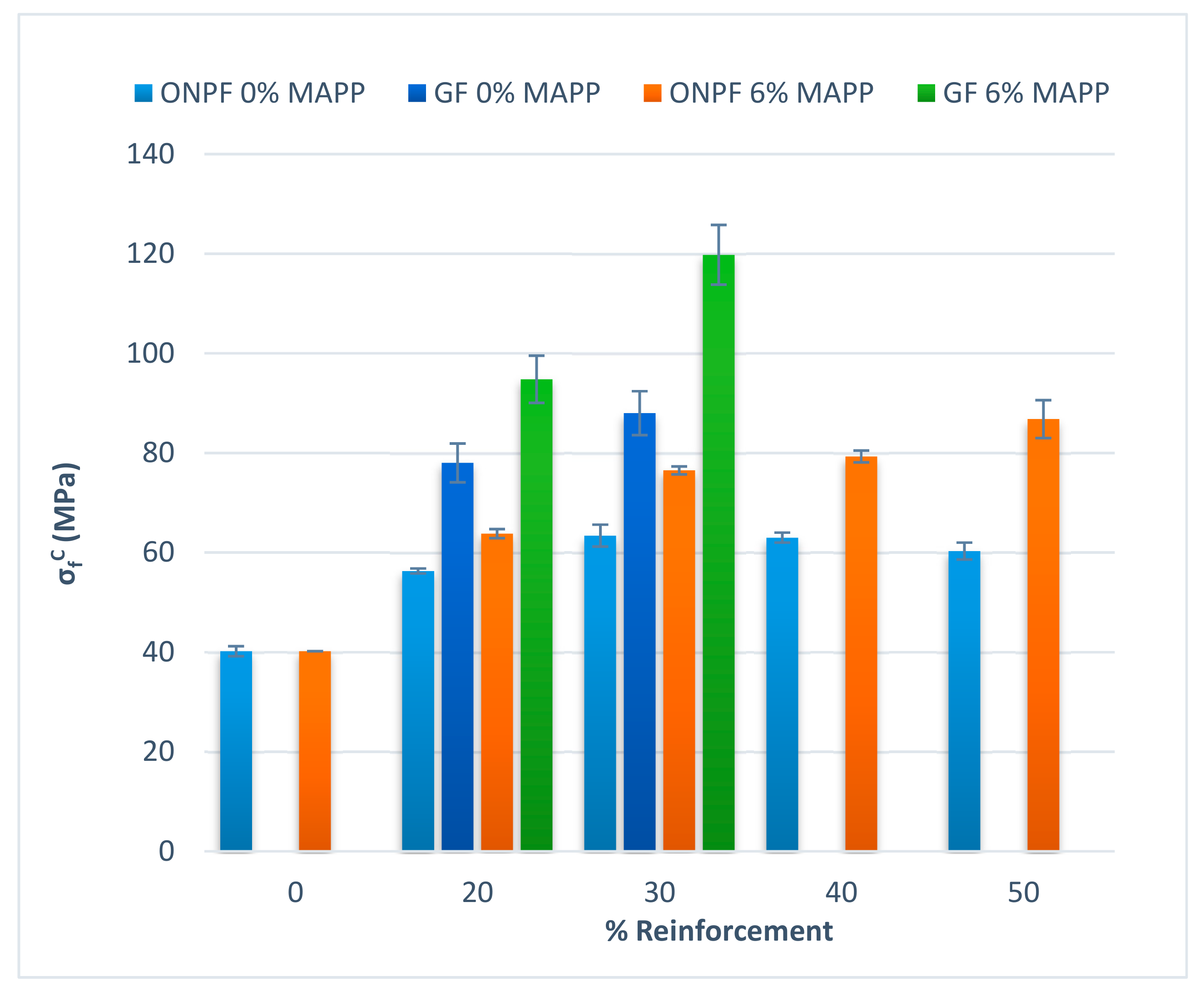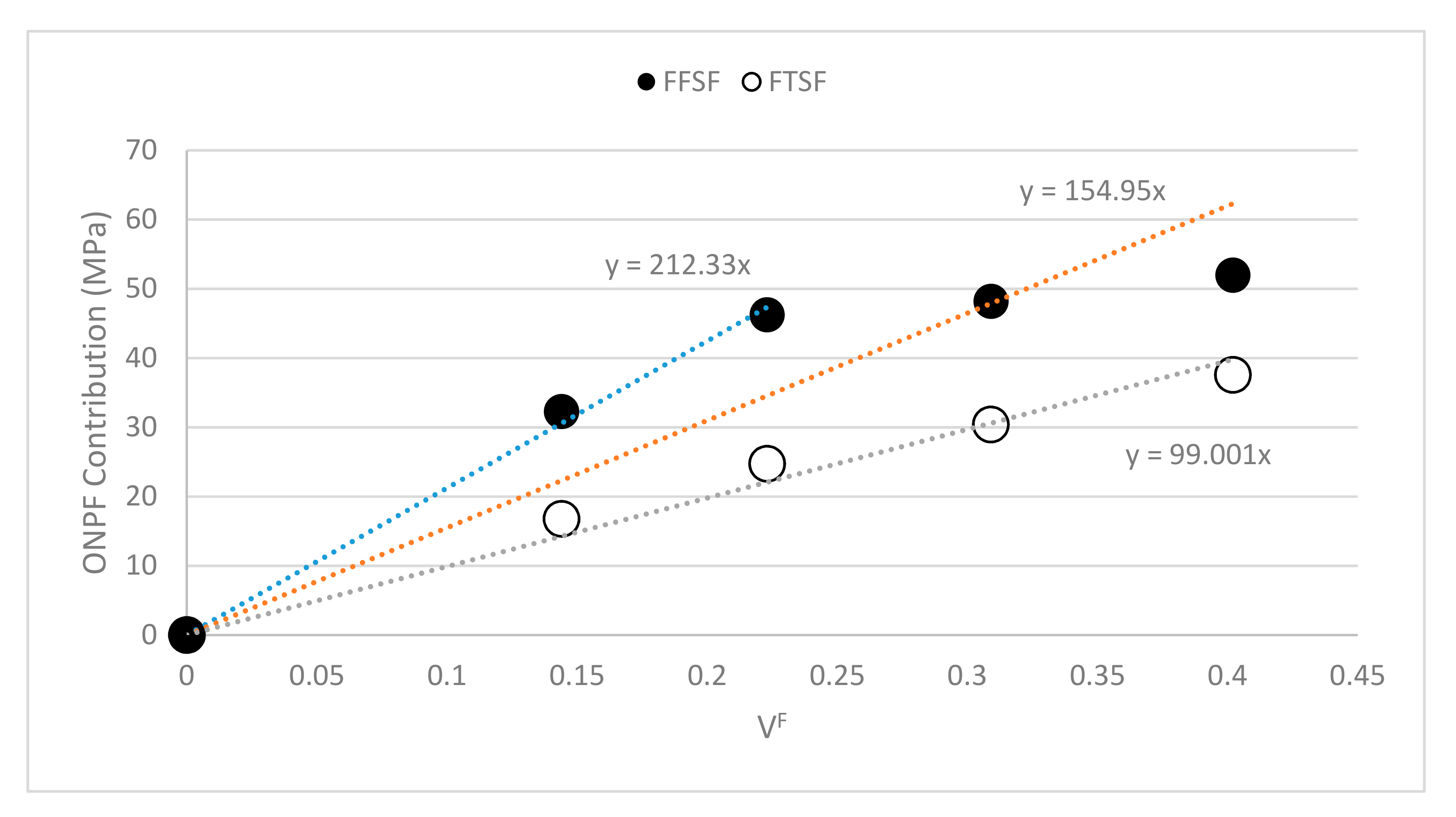Flexural Properties and Mean Intrinsic Flexural Strength of Old Newspaper Reinforced Polypropylene Composites
Abstract
:1. Introduction
2. Materials and Methods
2.1. Materials
2.2. Obtention of the Reinforcing Fibers
2.3. Composite Preparation and Sample Obtaining
2.4. Mechanical Characterization
2.5. Morphology of the Fibers
3. Results and Discussion
3.1. Flexural Properties of the Composites
3.2. Competitiveness of ONPF Reinforced PP Composites
3.3. Analysis of the Contribution of ONPF and its Intrinsic Flexural Strength
4. Conclusions
Author Contributions
Funding
Acknowledgments
Conflicts of Interest
References
- Serrano, A.; Espinach, F.; Tresserras, J.; Pellicer, N.; Alcalà, M.M.; Mutjé, P. Study on the technical feasibility of replacing glass fibers by old newspaper recycled fibers as polypropylene reinforcement. J. Clean. Prod. 2014, 65, 489–496. [Google Scholar] [CrossRef]
- Huda, M.; Drzal, L.; Mohanty, A.; Misra, M. Chopped glass and recycled newspaper as reinforcement fibers in injection molded poly(lactic acid) (PLA) composites: A comparative study. Compos. Sci. Technol. 2006, 66, 1813–1824. [Google Scholar] [CrossRef]
- Lykidis, C.; Parnavela, C.; Goulounis, N.; Grigoriou, A.; Gkoulounis, N. Potential for utilizing waste corrugated paper containers into wood composites using UF and PMDI resin systems. Eur. J. Wood Wood Prod. 2012, 70, 811–818. [Google Scholar] [CrossRef]
- Ardanuy, M.; Antunes, M.; Velasco, J.I. Vegetable fibres from agricultural residues as thermo-mechanical reinforcement in recycled polypropylene-based green foams. Waste Manag. 2012, 32, 256–263. [Google Scholar] [CrossRef] [PubMed]
- Serra, A.; Tarrés, Q.; Llop, M.; Reixach, R.; Mutjé, P.; Espinach, F.X. Recycling dyed cotton textile byproduct fibers as polypropylene reinforcement. Text. Res. J. 2018, 89, 2113–2125. [Google Scholar] [CrossRef]
- Oliver-Ortega, H.; Méndez, J.A.; Reixach, R.; Espinach, F.X.; Ardanuy, M.; Mutjé, P. Towards More Sustainable Material Formulations: A Comparative Assessment of PA11-SGW Flexural Performance versus Oil-Based Composites. Polymers 2018, 10, 440. [Google Scholar] [CrossRef] [PubMed]
- Lau, K.T.; Hung, P.Y.; Zhu, M.H.; Hui, D. Properties of natural fibre composites for structural engineering applications. Compos. Part B Eng. 2018, 136, 222–233. [Google Scholar] [CrossRef]
- Serrano, A.; Espinach, F.; Tresserras, J.; Del Rey, R.; Pellicer, N.; Mutjé, P. Macro and micromechanics analysis of short fiber composites stiffness: The case of old newspaper fibers–polypropylene composites. Mater. Des. 2014, 55, 319–324. [Google Scholar] [CrossRef]
- López, J.; Mutjé, P.; Carvalho, A.; Curvelo, A.; Gironès, J.; Carvalho, A. Newspaper fiber-reinforced thermoplastic starch biocomposites obtained by melt processing: Evaluation of the mechanical, thermal and water sorption properties. Ind. Crop. Prod. 2013, 44, 300–305. [Google Scholar] [CrossRef]
- Vilaseca, F.; Del Rey, R.; Serrat, R.; Alba, J.; Mutjé, P.; Espinach, F.X. Macro and micro-mechanics behavior of stifness in alkaline treated hemp core fibres polypropylene-based composites. Compos. Part B Eng. 2018, 144, 118–125. [Google Scholar] [CrossRef]
- Serrano, A.; Espinach, F.X.; Julian, F.; del Rey, R.; Mendez, J.A.; Mutje, P. Estimation of the interfacial shears strength, orientation factor and mean equivalent intrinsic tensile strength in old newspaper fiber / polypropylene composites. Compos. Part B Eng. 2013, 50, 232–238. [Google Scholar] [CrossRef]
- Nassar, M.; Abdelwahab, N.; Elhalawany, N.; Abdelwahab, N. Contributions of polystyrene to the mechanical properties of blended mixture of old newspaper and wood pulp. Carbohydr. Polym. 2009, 76, 417–421. [Google Scholar] [CrossRef]
- Sanadi, A.R.; Young, R.; Clemons, C.; Rowell, R. Recycled Newspaper Fibers as Reinforcing Fillers in Thermoplastics: Part I-Analysis of Tensile and Impact Properties in Polypropylene. J. Reinf. Plast. Compos. 1994, 13, 54–67. [Google Scholar] [CrossRef]
- Osman, H.; Ismail, H.; Mariatti, M. Polypropylene/natural rubber composites filled with recycled newspaper: Effect of chemical treatment using maleic anhydride-grafted polypropylene and 3-aminopropyltriethoxysilane. Polym. Compos. 2012, 33, 609–618. [Google Scholar] [CrossRef]
- Osman, H.; Ismail, H.; Mustapha, M. Effects of Maleic Anhydride Polypropylene on Tensile, Water Absorption, and Morphological Properties of Recycled Newspaper Filled Polypropylene/Natural Rubber Composites. J. Compos. Mater. 2010, 44, 1477–1491. [Google Scholar] [CrossRef]
- Yuan, X.H.; Zhang, Y.X.; Zhang, X.F. Maleated polypropylene as a coupling agent for polypropylene-waste newspaper flour composites. J. Appl. Polym. Sci. 1999, 71, 333–337. [Google Scholar] [CrossRef]
- Kuo, P.Y.; Wang, S.Y.; Chen, J.H.; Hsueh, H.C.; Tsai, M.J. Effects of material compositions on the mechanical properties of wood–plastic composites manufactured by injection molding. Mater. Des. 2009, 30, 3489–3496. [Google Scholar] [CrossRef]
- Kaczmar, J.W.; Pach, J.; Burgstaller, C. The chemically treated hemp fibres to reinforce polymers. Polimers 2011, 56, 817–822. [Google Scholar] [CrossRef]
- Sawpan, M.A.; Pickering, K.L.; Fernyhough, A. Effect of fibre treatments on interfacial shear strength of hemp fibre reinforced polylactide and unsaturated polyester composites. Compos. Part A Appl. Sci. Manuf. 2011, 42, 1189–1196. [Google Scholar] [CrossRef] [Green Version]
- Fuqua, M.A.; Chevali, V.S.; Ulven, C.A. Lignocellulosic byproducts as filler in polypropylene: Comprehensive study on the effects of compatibilization and loading. J. Appl. Polym. Sci. 2013, 127, 862–868. [Google Scholar] [CrossRef]
- Birnin-Yauri, A.U.; Ibrahim, N.A.; Zainuddin, N.; Abdan, K.; Then, Y.Y.; Chieng, B.W. Effect of Maleic Anhydride-Modified Poly(lactic acid) on the Properties of Its Hybrid Fiber Biocomposites. Polymers 2017, 9, 165. [Google Scholar] [CrossRef] [PubMed]
- Reixach, R.; Franco-Marquès, E.; El Mansouri, N.-E.; De Cartagena, F.R.; Arbat, G.; Espinach, F.X.; Mutjé, P. Micromechanics of Mechanical, Thermomechanical, and Chemi-Thermomechanical Pulp from Orange Tree Pruning as Polypropylene Reinforcement: A Comparative Study. Bioresources 2013, 8, 3231–3246. [Google Scholar] [CrossRef]
- Granda, L.; Espinach, F.; López, F.; García, J.; Delgado-Aguilar, M.; Mutjé, P.; Espinach, X. Semichemical fibres of Leucaena collinsii reinforced polypropylene: Macromechanical and micromechanical analysis. Compos. Part B Eng. 2016, 91, 384–391. [Google Scholar] [CrossRef]
- De Carvalho, F.P.; Felisberti, M.I.; Oviedo, M.A.S.; Vargas, M.D.; Farah, M.; Ferreira, M.P.F. Rice Husk/Poly(propylene-co-ethylene) Composites: Effect of Different Coupling Agents on Mechanical, Thermal, and Morphological Properties. J. Appl. Polym. Sci. 2012, 123, 3337–3344. [Google Scholar] [CrossRef]
- Franco-Marquès, E.; Méndez, J.A.; Pèlach, M.A.; Vilaseca, F.; Bayer, J.; Mutjé, P. Influence of coupling agents in the preparation of polypropylene composites reinforced with recycled fibers. Chem. Eng. J. 2011, 166, 1170–1178. [Google Scholar] [CrossRef]
- Granda, L.; Espinach, F.; Méndez, J.A.; Tresserras, J.; Delgado-Aguilar, M.; Mutjé, P.; Espinach, F. Semichemical fibres of Leucaena collinsii reinforced polypropylene composites: Young’s modulus analysis and fibre diameter effect on the stiffness. Compos. Part B Eng. 2016, 92, 332–337. [Google Scholar] [CrossRef]
- Espinach, F.X.; Chamorro-Trenado, M.A.; Llorens, J.; Tresserras, J.; Pellicer, N.; Vilaseca, F.; Pèlach, A. Study of the Flexural Modulus and the Micromechanics of Old Newspaper Reinforced Polypropylene Composites. BioResources 2019, 14, 3578–3593. [Google Scholar]
- Espigule, E.; Vilaseca, F.; Puigvert, X.; El Mansouri, N.-E.; Espinach, F.-X.; Verdaguer, N.; Mutje, P. Biocomposites from Starch-based Biopolymer and Rape Fibers. Part I: Interfacial Analysis and Intrinsic Properties of Rape Fibers. Curr. Org. Chem. 2013, 17, 1633–1640. [Google Scholar] [CrossRef]
- Espinach, F.; Delgado-Aguilar, M.; Puig, J.; Julian, F.; Boufi, S.; Mutjé, P.; Espinach, F. Flexural properties of fully biodegradable alpha-grass fibers reinforced starch-based thermoplastics. Compos. Part B Eng. 2015, 81, 98–106. [Google Scholar] [CrossRef]
- Lopez, J.P.; Mendez, J.A.; El Mansouri, N.E.; Mutje, P.; Vilaseca, F. Mean intrinsic tensile properties of stone groundwood fibers from softwood. BioResources 2011, 6, 5037–5049. [Google Scholar] [CrossRef]
- Lopez, J.P.; Mendez, J.A.; Espinach, F.X.; Julian, F.; Mutje, P.; Vilaseca, F. Tensile Strength characteristics of Polypropylene composites reinforced with Stone Groundwood fibers from Softwood. BioResources 2012, 7, 3188–3200. [Google Scholar] [CrossRef]
- Granda, L.; Espinach, F.; Tarrés, Q.; Méndez, J.A.; Delgado-Aguilar, M.; Mutjé, P.; Espinach, F. Towards a good interphase between bleached kraft softwood fibers and poly(lactic) acid. Compos. Part B Eng. 2016, 99, 514–520. [Google Scholar] [CrossRef]
- Méndez, J.A.; Vilaseca, F.; Pèlach, M.À.; Lopez, J.P.; Barbera, L.; Turon, X.; Gironès, J.; Mutjé, P. Evaluation of the reinforcing effect of ground wood pulp in the preparation of polypropylene-based composites coupled with maleic anhydride grafted polypropylene. J. Appl. Polym. Sci. 2007, 105, 3588–3596. [Google Scholar]
- López, J.; Gironès, J.; Méndez, J.A.; Pèlach, M.À.; Vilaseca, F.; Mutjé, P. Impact and flexural properties of stone-ground wood pulp-reinforced polypropylene composites. Polym. Compos. 2013, 34, 842–848. [Google Scholar]
- Gironès, J.; López, J.; Vilaseca, F.; Bayer, J.B.; Herrera-Franco, P.; Mutjé, P. Biocomposites from Musa textilis and polypropylene: Evaluation of flexural properties and impact strength. Compos. Sci. Technol. 2011, 71, 122–128. [Google Scholar]
- Julián, F.; Méndez, J.A.; Espinach, F.X.; Verdaguer, N.; Mutjé, P.; Vilaseca, F. Bio-based composites from stone groundwood applied to new product development. BioResources 2012, 7, 5829–5842. [Google Scholar] [CrossRef]
- Hashemi, S.; Khamsehnezhad, A. Analysis of tensile and flexural strengths of single and double gated injection moulded short glass fibre reinforced PBT/PC composites. Plast. Rubber Compos. 2010, 39, 343–349. [Google Scholar] [CrossRef]
- Kallel, T.K.; Taktak, R.; Guermazi, N.; Mnif, N. Mechanical and structural properties of glass fiber-reinforced polypropylene (PPGF) composites. Polym. Compos. 2018, 39, 3497–3508. [Google Scholar] [CrossRef]
- Delgado-Aguilar, M.; Julián, F.; Tarrés, Q.; Méndez, J.A.; Mutjé, P.; Espinach, F. Bio composite from bleached pine fibers reinforced polylactic acid as a replacement of glass fiber reinforced polypropylene, macro and micro-mechanics of the Young’s modulus. Compos. Part B Eng. 2017, 125, 203–210. [Google Scholar] [CrossRef]
- Jiménez, A.M.; Espinach, F.X.; Delgado-Aguilar, M.; Reixach, R.; Quintana, G.; Fullana-I-Palmer, P.; Mutjé, P. Starch-Based Biopolymer Reinforced with High Yield Fibers from Sugarcane Bagasse as a Technical and Environmentally Friendly Alternative to High Density Polyethylene. Bioresources 2016, 11, 9856–9868. [Google Scholar]








| Composite | VF (v/v) | σfC (MPa) | EfC (GPa) | εfC (%) | σfm* (MPa) |
|---|---|---|---|---|---|
| PP | 0 | 40.2 ± 0.6 | 1.1 ± 0.12 | 6.5 ± 0.25 | 40.2 ± 0.6 |
| 20%ONPF–0%MAPP | 0.144 | 53.6 ± 1.0 | 2.1 ± 0.16 | 3.7 ± 0.16 | 53.6 ± 1.0 |
| 30%ONPF–0%MAPP | 0.223 | 63.4 ± 0.5 | 2.7 ± 0.22 | 2.7 ± 0.11 | 63.4 ± 0.5 |
| 40%ONPF–0%MAPP | 0.309 | 63.0 ± 1.8 | 3.1 ± 0.19 | 2.6 ± 0.13 | 63.0 ± 1.8 |
| 50%ONPF–0%MAPP | 0.402 | 60.3 ± 1.7 | 4.0 ± 0.23 | 1.6 ± 0.12 | 60.3 ± 1.7 |
| 20%ONPF–6%MAPP | 0.144 | 63.8 ± 0.9 | 2.2 ± 0.14 | 4.2 ± 0.18 | 63.8 ± 0.9 |
| 30%ONPF–6%MAPP | 0.223 | 76.5 ± 0.8 | 2.5 ± 0.18 | 4.0 ± 0.15 | 76.5 ± 0.8 |
| 40%ONPF–6%MAPP | 0.309 | 79.3 ± 1.2 | 3.2 ± 0.24 | 2.6 ± 0.13 | 79.3 ± 1.2 |
| 50%ONPF–6%MAPP | 0.402 | 86.8 ± 2.3 | 4.1 ± 0.21 | 2.5 ± 0.14 | 86.8 ± 2.3 |
© 2019 by the authors. Licensee MDPI, Basel, Switzerland. This article is an open access article distributed under the terms and conditions of the Creative Commons Attribution (CC BY) license (http://creativecommons.org/licenses/by/4.0/).
Share and Cite
Tarrés, Q.; Soler, J.; Rojas-Sola, J.I.; Oliver-Ortega, H.; Julián, F.; Espinach, F.X.; Mutjé, P.; Delgado-Aguilar, M. Flexural Properties and Mean Intrinsic Flexural Strength of Old Newspaper Reinforced Polypropylene Composites. Polymers 2019, 11, 1244. https://doi.org/10.3390/polym11081244
Tarrés Q, Soler J, Rojas-Sola JI, Oliver-Ortega H, Julián F, Espinach FX, Mutjé P, Delgado-Aguilar M. Flexural Properties and Mean Intrinsic Flexural Strength of Old Newspaper Reinforced Polypropylene Composites. Polymers. 2019; 11(8):1244. https://doi.org/10.3390/polym11081244
Chicago/Turabian StyleTarrés, Quim, Jordi Soler, José Ignacio Rojas-Sola, Helena Oliver-Ortega, Fernando Julián, F. Xavier Espinach, Pere Mutjé, and Marc Delgado-Aguilar. 2019. "Flexural Properties and Mean Intrinsic Flexural Strength of Old Newspaper Reinforced Polypropylene Composites" Polymers 11, no. 8: 1244. https://doi.org/10.3390/polym11081244






